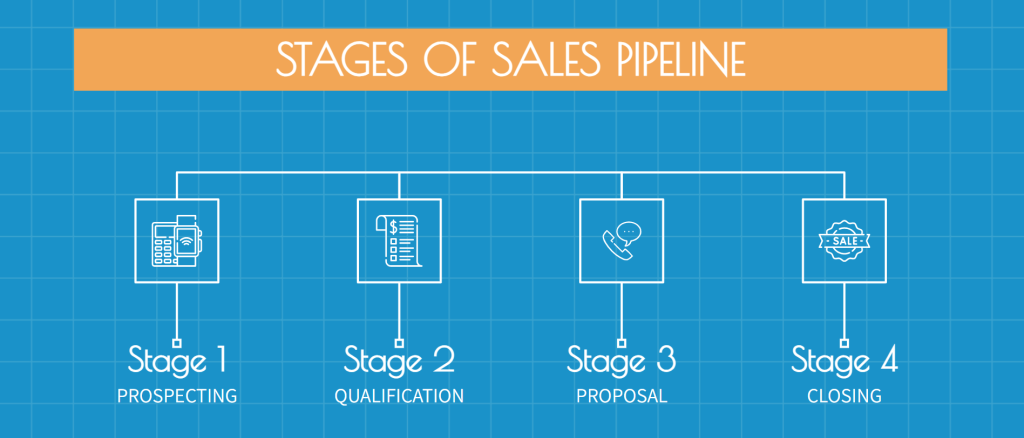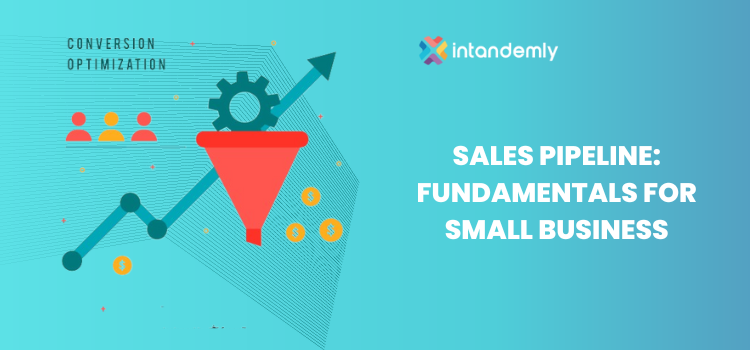Sales Pipeline: Fundamentals for Small Business
INTRODUCTION:
In the world of business, sales are the lifeblood that keeps companies thriving.Without sales, you can't generate revenue, and without revenue, you can't grow your business. That's why having a solid sales pipeline is crucial. A sales pipeline is a visual representation of your sales process.Small businesses, in particular, heavily rely on a well-structured sales pipeline to generate revenue and drive growth.It helps you organize and streamline your sales process, making it easier to track leads, close deals, and grow your business.In this blog post, we'll cover the basics of sales pipelines, including what they are, why they're important, and how to build one for your small business.
What is Sales Pipeline?
A pipeline, in the context of business, represents the systematic flow of prospects or clients through various stages of the sales process. It outlines the various stages that a lead goes through on their way to becoming a customer. It shows the path from initial contact and lead qualification to negotiation and ultimately closing a deal and ending in a successful sale.This pipeline helps you keep track of where each lead is in the process, what needs to be done to move them to the next stage, and what the next steps are for closing the deal.A well-structured pipeline enables businesses to streamline their sales process, optimize resource allocation, and maximize revenue generation.
Importance of a Sales Pipeline:
Prioritizing Leads:
One of the most important benefits of a sales pipeline is that it helps you prioritize your leads. A well-defined sales pipeline provides a clear visual representation of where each lead or prospect stands in the buying process.By organizing your leads into stages, you can focus your efforts on those that are most likely to convert and ensuring that no potential sale slips through the cracks.This can save you time and resources, and help you close deals more efficiently.Efficient Sales Process:
The sales pipeline helps streamline the sales process by breaking it down into manageable stages. This structure ensures that sales representatives follow a systematic approach, reducing the chances of missing out on key opportunities. With a well-defined pipeline, it becomes easier to track customer interactions, follow up on leads, and ultimately close deals more efficiently.Improved Accountability:
A sales pipeline provides a clear roadmap for your sales team, making it easier for them to stay on track and achieve their goals. Moreover,the sales pipeline serves as a performance management tool for sales teams. It allows managers to evaluate individual and team performance by tracking the movement of leads through the pipeline. By identifying bottlenecks or areas of improvement, managers can provide targeted coaching and support, leading to enhanced sales performance.Revenue Forecasting:
A structured sales pipeline enables businesses to forecast and predict your future sales revenue.By tracking your leads through each stage of the pipeline, you can estimate how many deals you will close in the future and how much revenue you will generate. This can help you plan your finance and allocate resources more effectively.Driven Decision Making:
Finally, a sales pipeline enables data-driven decision making. By tracking key performance indicators (KPIs) such as conversion rates, sales cycle length, and deal size, you can analyze your sales data and make informed decisions about how to improve your sales process.Stages of Sales Pipeline:
Stage 1: Prospecting
It involves seeking out individuals or businesses who might be interested in your product or service.This stage involves identifying potential leads and gathering information about their needs, preferences, and budgets. For instance, if you run a fitness equipment store, you might use social media ads to catch the attention of fitness enthusiasts.Similarly,you can use social media, email marketing, cold calling or other methods to reach out to potential customers and collect their contact information.Stage 2: Qualification
Not every fish caught in the net is a prize catch. Once leads are identified, they need to be qualified to ensure they meet specific criteria and have a genuine interest in the product or service.At this stage, you begin to qualify your leads by determining whether they are a good fit for your business and sorting through the prospects to identify those with genuine potential to become customers. It involves conducting thorough research, asking relevant questions, and assessing the lead's fit with the business's offerings.
Stage 3: Proposal
After a lead is qualified, the next step is to present a proposal that addresses their specific needs. At this stage, you present your product or service to the lead and demonstrate how it can meet their needs. You might use a demo, a proposal, or other methods to showcase your offering and explain its benefits.Sales teams should focus on highlighting the unique value proposition and differentiating themselves from competitors.For Example,If you're a software vendor, this is when you showcase how your software can streamline their operations, talk about different features, different pricing plans and tell about the USPs of your software.Stage 4: Closing
The last stage of the sales pipeline is about closing the deal. This involves negotiation, finalizing terms, and securing the customer's commitment. Effective communication, active listening, and addressing any remaining concerns are essential during this stage to avoid misunderstanding.How to build an Effective Pipeline?
Define Stages:
Divide your pipeline into distinct stages that reflect your sales process. Create a pipeline tailored to your business.Start with key stages such as lead generation, prospect qualification, proposal, negotiation, and closing.You might use the stages we outlined above, or you might need to adjust them to fit your business and your sales process.Each stage should have well-defined criteria, making it easier to track progress.Implementing a CRM System:
This step involves implementing a CRM system.It organizes customer data, tracks interactions, ensures seamless communication. By implementing a CRM system, you streamline your processes, leading to enhanced customer insights and personalized engagement.It can also track leads, manage customer interactions, and monitor the progress of each prospect in the pipeline. This will provide valuable insights and allow for efficient collaboration within the sales team.Defining Goals:
The next step is to establish measurable goals and key performance indicators (KPIs) to track the success of your sales pipeline. It's about defining what you want to achieve and establishing benchmarks to measure progress.This will help you identify areas for improvement and optimize your sales process.For small businesses, goals might range from boosting revenue and increasing lead conversion rates to improving customer retention. The key is specificity. For instance, instead of aiming to "increase revenue," you could set a goal to "increase monthly revenue by 15% within the next quarter." Such specificity provides a clear direction and a tangible target to work towards.
Train the Team:
A ship is only as good as its crew. Similarly, the effectiveness of your sales pipeline hinges on the expertise and skills of your sales team. Invest in training and development programs to equip your sales team with the necessary skills and knowledge to effectively engage with customers. Investing in training pays off. Studies have shown that companies that invest in training have 218% higher income per employee and a 24% higher profit margin. Well-prepared teams are more motivated, confident, and capable of delivering the best.CONCLUSION:
An effective sales pipeline is a vital component of small businesses' success for instance it can be the thread that weaves together success.It helps you to organize and streamline your sales process, making it easier to track leads, close deals, and grow your business.By understanding the stages of a sales pipeline and implementing the right strategies, small businesses can build an efficient and productive sales pipeline.Remember, building a sales pipeline is not a one-time task. It is an ongoing process that requires continuous monitoring, refining, and adaptation.The key lies in understanding your customers, adapting to their needs, and consistently refining your approach.By analyzing your pipeline regularly, you can identify areas of improvement and adjust your strategy accordingly. With a well-defined sales pipeline in place, you'll be well on your way to growing your business and achieving your sales goals.Start building your sales pipeline today, and witness your small business flourish.








